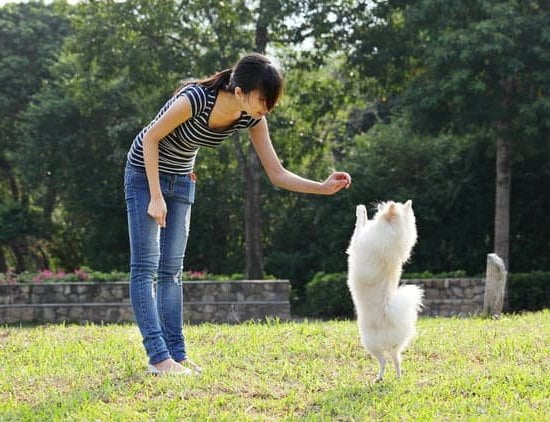Are you wondering how to train your dog to sit step by step? Teaching your furry friend the sit command is not only a fundamental part of obedience training but also a building block for more advanced commands. In this article, we will explore the importance of teaching your dog to sit and provide a comprehensive guide on how to do so effectively.
Understanding the basics of dog training and positive reinforcement is essential before embarking on teaching your dog new commands. Positive reinforcement methods have been proven to be the most effective and humane way to train dogs, and we will delve into this in detail.
Creating the right environment for training is crucial for success. We will discuss how to prepare a conducive space for training, free from distractions and with the necessary tools at hand. So if you’re ready to embark on this training journey with your furry friend, keep reading for our step by step guide on teaching your dog to sit.
In the next sections, we will cover how to establish eye contact with your dog, gain their attention, and provide a detailed guide on teaching the sit command using hand signals and vocal cues. Additionally, we will touch upon common mistakes to avoid during training and provide tips for maintaining consistency and patience throughout the process. Finally, we will address troubleshooting tips for stubborn dogs or those struggling to learn the command. Stay tuned for expert advice and guidance.
Understanding the Basics of Dog Training and Positive Reinforcement
Training your dog to sit is an essential command that can help in managing their behavior and ensuring they are well-behaved. Understanding the basics of dog training and positive reinforcement is crucial in this process. Positive reinforcement is a powerful tool in dog training, as it encourages desirable behaviors by rewarding them, making the behavior more likely to be repeated. Here are some key points to consider when understanding the basics of dog training and positive reinforcement:
- Consistency is key: It’s important to be consistent in your commands and rewards when training your dog. Use the same vocal cues and hand signals each time you ask your dog to sit, and reward them with a treat or praise immediately after they obey.
- Timing is everything: Dogs live in the present moment, so it’s important to reward them immediately after they perform the desired behavior. This helps them make the connection between their action and the reward.
- Avoid punishment: Instead of punishing your dog for not sitting, focus on rewarding them when they do sit. Punishment can lead to fear or anxiety in dogs, which can hinder their learning process.
By understanding these fundamental principles of dog training and positive reinforcement, you can create a conducive environment for teaching your dog to sit effectively. Remember that patience, consistency, and positivity are essential for successful training.
As pet owners know well, every canine companion has its quirks – from stubbornness to pickiness with treats. In the next section, we will delve into the importance of preparing the right environment for training your furry friend.
Preparing the Right Environment for Training
Before you begin training your dog to sit, it is crucial to prepare the right environment for a successful learning experience. First and foremost, choose a quiet and distraction-free area for the training session. This will help your dog stay focused and attentive during the teaching process. Eliminate any potential sources of distraction such as other pets, loud noises, or unfamiliar people.
Additionally, ensure that the training area is well-lit and spacious enough for both you and your dog to move around comfortably. Having enough space will allow your dog to understand and follow your hand signals and vocal cues effectively. A well-lit environment also makes it easier for your dog to see and interpret your gestures during the training process.
Lastly, gather all the necessary training materials such as treats, toys, a leash, and a clicker if you decide to incorporate one into your training regimen. These items will help create a positive and rewarding learning experience for your dog as you teach them the sit command.
| Important Points | Details |
|---|---|
| Distraction-Free Area | Choose a quiet location without distractions. |
| Well-Lit Space | Ensure good lighting in the training area. |
| Training Materials | Gather treats, toys, leash, and clicker if using one. |
The First Step
Before you begin training your dog to sit, it’s important to establish eye contact and gain their attention. This step is crucial as it sets the foundation for successful training sessions. Start by finding a quiet, distraction-free environment where you can work with your dog without interruptions. This could be a designated area in your home or a peaceful spot in your backyard.
Once you have found the right environment, make sure to have some high-value treats on hand. These treats will serve as a reward for your dog during the training process. When you have your dog’s attention, you can then move on to the next steps of teaching them to sit. It’s important to remain patient and consistent during this process, as every dog learns at their own pace.
Establishing eye contact and gaining your dog’s attention may take time, especially if they are easily distracted. Be patient and use positive reinforcement techniques such as praise and treats to encourage them to focus on you. Remember that building a strong bond with your dog is essential for successful training, so take the time to create a positive and supportive learning environment for them.
| Training Environment | Tips |
|---|---|
| Find a quiet, distraction-free place | This will help keep your dog focused during training sessions. |
| Use high-value treats as rewards | Rewarding your dog with treats will motivate them during training. |
Step by Step Guide to Teaching the Sit Command, Including Hand Signals and Vocal Cues
Teaching your dog to sit is an essential aspect of obedience training, and it can also be a building block for more advanced commands. Here’s a step-by-step guide to teaching the sit command to your dog, including hand signals and vocal cues:
1. **Start with the Basics**: Before starting the training process, make sure your dog is in a calm state of mind. Use treats or toys that your dog loves to create positive reinforcement during the training.
2. **The Hand Signal**: Begin by holding a treat in front of your dog’s nose to get their attention. Slowly move the treat up and back over their head, which will naturally cause them to lower their bottom to the ground as they try to keep their eyes on the treat. As soon as they are in a sitting position, reward them with the treat and praise.
3. **Vocal Cues**: In conjunction with the hand signal, introduce a verbal cue such as “sit.” Repeat this process several times until your dog starts associating the word “sit” with the action of sitting down.
4. **Consistency is Key**: It’s important to be consistent with your hand signal and vocal cue every time you ask your dog to sit. Using the same gestures and words will help reinforce their understanding of the command.
5. **Eliminating Treats**: Once your dog consistently responds to both hand signals and vocal cues, start reducing the frequency of treats while still offering praise every time they obey the command. This will encourage them to continue following your instructions even without immediate rewards.
By following these steps and being patient, consistent, and persistent in your training efforts, you are likely to see progress in helping your furry friend master the sit command.
Common Mistakes to Avoid During Training
Not Using Positive Reinforcement
One common mistake to avoid when training your dog to sit is not using positive reinforcement. It’s essential to reward your dog with treats, praise, and affection when they successfully follow the command. This will help them associate sitting with a positive experience and encourage them to continue obeying the cue.
Inconsistency in Training
Another mistake to avoid is being inconsistent with your training sessions. Dogs thrive on routine, so it’s important to have regular, structured training sessions to teach them the sit command. Inconsistency can lead to confusion for your dog and may result in them not fully understanding what is expected of them.
Using Punishment or Force
Using punishment or force during training is another mistake that should be avoided at all costs. This can create fear and anxiety in your dog, leading to negative associations with the training process. Instead, focus on positive reinforcement and patience to effectively teach your dog to sit without any form of punishment or force.
By avoiding these common mistakes during training, you can set your dog up for success in learning the sit command and other essential obedience skills. Consistency, patience, and positive reinforcement are key elements in successful dog training techniques that will result in a well-behaved and obedient companion.
Practice Makes Perfect
Consistency and patience are key elements when it comes to training your dog to sit. It is important to understand that learning a new command takes time and effort, so being consistent with your training schedule and patient with your dog is crucial for successful results.
Consistency means practicing the sit command regularly, using the same cues and hand signals every time. It also means enforcing the rules consistently, such as not allowing your dog to sit on command in some situations but not in others.
Patience is equally important when teaching your dog to sit. Some dogs may pick up the command quickly, while others may take longer to understand and obey. It’s important to remain patient and not get frustrated if your dog doesn’t grasp the concept right away. Dogs respond best to positive reinforcement and encouragement, so maintaining a calm demeanor during training sessions will help create a positive learning environment for your pet.
One tip for consistency and patience is to keep training sessions short and frequent. Aim for multiple short sessions throughout the day rather than one long session, as this will help reinforce the sit command without overwhelming your dog. Remember that every dog is different, so be patient and keep practicing until your furry friend has mastered the sit command in various scenarios and environments.
Reinforcing the Sit Command in Different Scenarios and Environments
Once your dog has mastered the sit command in a controlled environment, it’s important to reinforce this behavior in different scenarios and environments. Dogs don’t generalize well, so they may not understand that the sit command applies everywhere unless specifically trained to do so.
Practice in Various Locations
Take your dog to different places such as parks, streets, and friends’ houses and practice the sit command there. This will help them understand that sitting is expected in all environments, not just at home.
Distraction Training
Introduce distractions while practicing the sit command. This could be other people, other dogs, or even food around them. By doing this, you are teaching your dog to focus and obey the command amidst various distractions.
Transitioning to Off-Leash Training
As your dog becomes more consistent with the sit command on a leash, start practicing off-leash in safe areas. This will further reinforce the idea that the command applies regardless of whether they are on a leash or not.
By reinforcing the sit command in different scenarios and environments, you are ensuring that your dog understands and obeys the command consistently no matter where they are. It takes time and patience, but with consistent training, your dog will learn to sit on cue in any situation.
Troubleshooting Tips for Stubborn Dogs or Those Struggling to Learn the Command
In conclusion, teaching your dog to sit is an essential command that sets the foundation for more advanced training and improves behavior. With the use of positive reinforcement and consistency, you can effectively train your dog to sit in various scenarios and environments. However, some dogs may be more stubborn or struggle to learn the command, requiring additional troubleshooting tips and patience.
When dealing with stubborn dogs or those struggling to learn the sit command, it’s important to assess the approach and methods being used during training. Sometimes a different approach or technique may be necessary to better communicate with your dog. It’s important to remain patient and persistent, as every dog learns at their own pace.
One common troubleshooting tip is to try using higher value rewards such as favorite treats or toys to motivate a stubborn dog or one that is struggling with learning the sit command. Additionally, seeking the help of a professional dog trainer can provide valuable insight and guidance on how to overcome training obstacles.
Remember, every dog has their own unique personality and learning style, so it’s essential to tailor the training approach accordingly. With time, patience, and dedication, even the most stubborn dogs can be successfully trained to sit on command.
Frequently Asked Questions
What Is the First Step in Teaching a Dog to Sit?
The first step in teaching a dog to sit is to get their attention and hold a treat in front of their nose. Then, slowly move the treat up and back over their head, which will cause them to naturally sit down. As soon as they do, give them the treat and praise them.
How Long Does It Take to Train a Dog How Do You Sit?
The length of time it takes to train a dog to sit can vary depending on the individual dog and the consistency of the training. Some dogs may learn to sit in just a few sessions, while others may take several weeks of consistent practice. Patience and positive reinforcement are key in the training process.
How Do You Train a Dog 10 Steps?
When training a dog, there are several important steps to follow. First, establish yourself as the leader and use positive reinforcement techniques such as treats, praise, and toys. Next, be consistent with your commands and expectations.
Use short training sessions and gradually increase the level of difficulty as your dog progresses. Always remain patient and never use harsh punishment methods during training. Finally, make sure to reinforce good behaviors consistently.

Welcome to the blog! I am a professional dog trainer and have been working with dogs for many years. In this blog, I will be discussing various topics related to dog training, including tips, tricks, and advice. I hope you find this information helpful and informative. Thanks for reading!





